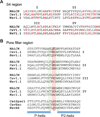Sodium leak channels in neuronal excitability and rhythmic behaviors
- PMID: 22196327
- PMCID: PMC3247702
- DOI: 10.1016/j.neuron.2011.12.007
Sodium leak channels in neuronal excitability and rhythmic behaviors
Abstract
Extracellular K⁺, Na⁺, and Ca²⁺ ions all influence the resting membrane potential of the neuron. However, the mechanisms by which extracellular Na⁺ and Ca²⁺ regulate basal neuronal excitability are not well understood. Recent findings suggest that NALCN, in association with UNC79 and UNC80, contributes a basal Na⁺ leak conductance in neurons. Mutations in Nalcn, Unc79, or Unc80 lead to severe phenotypes that include neonatal lethality and disruption in rhythmic behaviors. This review discusses the properties of the NALCN complex, its regulation, and its contribution to neuronal function and animal behavior.
Copyright © 2011 Elsevier Inc. All rights reserved.
Figures





Similar articles
-
Extracellular calcium controls background current and neuronal excitability via an UNC79-UNC80-NALCN cation channel complex.Neuron. 2010 Nov 4;68(3):488-99. doi: 10.1016/j.neuron.2010.09.014. Neuron. 2010. PMID: 21040849 Free PMC article.
-
UNC79 and UNC80, putative auxiliary subunits of the NARROW ABDOMEN ion channel, are indispensable for robust circadian locomotor rhythms in Drosophila.PLoS One. 2013 Nov 5;8(11):e78147. doi: 10.1371/journal.pone.0078147. eCollection 2013. PLoS One. 2013. PMID: 24223770 Free PMC article.
-
Genetic variants in components of the NALCN-UNC80-UNC79 ion channel complex cause a broad clinical phenotype (NALCN channelopathies).Hum Genet. 2018 Sep;137(9):753-768. doi: 10.1007/s00439-018-1929-5. Epub 2018 Aug 23. Hum Genet. 2018. PMID: 30167850 Free PMC article.
-
New insights into the physiology and pathophysiology of the atypical sodium leak channel NALCN.Physiol Rev. 2024 Jan 1;104(1):399-472. doi: 10.1152/physrev.00014.2022. Epub 2023 Aug 24. Physiol Rev. 2024. PMID: 37615954 Review.
-
NALCN: a regulator of pacemaker activity.Mol Neurobiol. 2012 Jun;45(3):415-23. doi: 10.1007/s12035-012-8260-2. Epub 2012 Apr 4. Mol Neurobiol. 2012. PMID: 22476981 Review.
Cited by
-
Predicting 'pain genes': multi-modal data integration using probabilistic classifiers and interaction networks.Bioinform Adv. 2024 Oct 18;4(1):vbae156. doi: 10.1093/bioadv/vbae156. eCollection 2024. Bioinform Adv. 2024. PMID: 39526039 Free PMC article.
-
RNA Interference Unleashed: Current Perspective of Small Interfering RNA (siRNA) Therapeutics in the Treatment of Neuropathic Pain.ACS Pharmacol Transl Sci. 2024 Sep 23;7(10):2951-2970. doi: 10.1021/acsptsci.4c00329. eCollection 2024 Oct 11. ACS Pharmacol Transl Sci. 2024. PMID: 39416962 Review.
-
Mathematical modeling of intracellular osmolarity and cell volume stabilization: The Donnan effect and ion transport.J Gen Physiol. 2024 Aug 5;156(8):e202413554. doi: 10.1085/jgp.202413554. Epub 2024 Jul 12. J Gen Physiol. 2024. PMID: 38995224
-
Sequence variations and accessory proteins adapt TMC functions to distinct sensory modalities.Neuron. 2024 Sep 4;112(17):2922-2937.e8. doi: 10.1016/j.neuron.2024.06.013. Epub 2024 Jul 9. Neuron. 2024. PMID: 38986620
-
A personal perspective of the voltage-gated potassium channel studies.Nat Struct Mol Biol. 2024 Apr;31(4):580-581. doi: 10.1038/s41594-024-01267-w. Nat Struct Mol Biol. 2024. PMID: 38548955 No abstract available.
References
-
- Arikkath J, Campbell KP. Auxiliary subunits: essential components of the voltage-gated calcium channel complex. Curr Opin Neurobiol. 2003;13:298–307. - PubMed
-
- Baruscotti M, Bucchi A, Viscomi C, Mandelli G, Consalez G, Gnecchi-Rusconi T, Montano N, Casali KR, Micheloni S, Barbuti A, DiFrancesco D. Deep bradycardia and heart block caused by inducible cardiac-specific knockout of the pacemaker channel gene Hcn4. Proc Natl Acad Sci U S A. 2011;108:1705–1710. - PMC - PubMed
Publication types
MeSH terms
Substances
Grants and funding
LinkOut - more resources
Full Text Sources
Other Literature Sources
Miscellaneous


